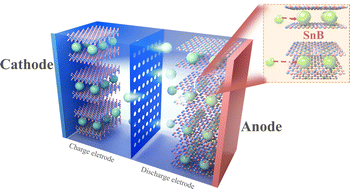A two-dimensional metallic SnB monolayer as an anode material for non-lithium-ion batteries†
Abstract
Na-, K- and Mg-ion batteries (NIBs, KIBs and MIBs) have drawn considerable interest due to their high abundance and excellent safety. However, the lack of high-performance anode materials is a major obstacle to its development. A metallic SnB planar monolayer is predicted by using the two-dimensional global minimum structure search method of swarm intelligence. Based on first-principles calculations, we proved that the metal SnB monolayer has high binding energy and excellent dynamical, thermal and mechanical stability. It is worth noting that the SnB monolayer has several stable adsorption sites for Na-, K- and Mg-ions, so it has a high theoretical capacity of 620.93, 517.44 and 620.93 mA h g−1, respectively. For Na-, K- and Mg-ion batteries, the low diffusion barriers of the SnB monolayer are 0.22, 0.07 and 0.68 eV, and the low average open circuit voltages are 0.42, 0.49 and 0.23 V, which ensure long service life and fast charging in practical applications. In addition, it is proved that the SnB monolayer maintains excellent conductivity and stability during the charge–discharge process. The results show that the SnB monolayer offers innovative advantages for the development of new two-dimensional planar structures that further advance the development of anode materials for metal ion batteries.



 Please wait while we load your content...
Please wait while we load your content...